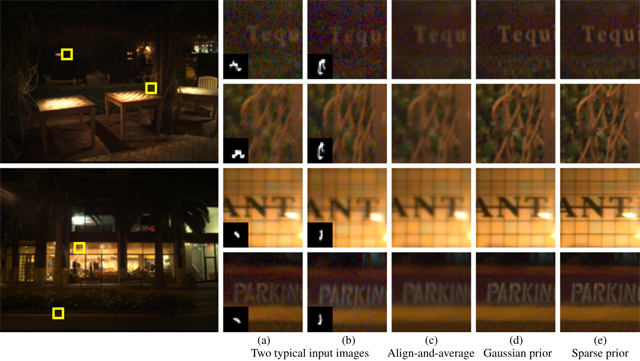Gyro-Based Multi-Image Deconvolution for Removing Handshake Blur
| Sung Hee Park | Marc Levoy |

Deblurring results from our system. Eight images are captured from a single burst at 5M-pixel resolution, while gyroscope data is recorded simultaneously. Each column in (a) and (b) shows two insets of an input image with their blur kernels shown at 2x size. Note the difference in shape of blur in two insets, which demonstrates spatially-varying blur. Input images are jointly deblurred with two different priors. The deblurred images in (d) and (e) removed handshake blur more effectively than in (c), where the input images are aligned and averaged.
Abstract
Paper : PDF
Supplemental Materials : Image examples
PhD Dissertation : Stanford Digital Repository
This dissertation includes the results of additional experiments beyond those reported in the paper.
Handling Moving Objects and Over-Exposed Regions
in Non-Blind Multi-Image Deconvolution
| Sung Hee Park | Marc Levoy |

Output images after combining the results of multi-image deconvolution and patch-based multi-image denoising. Eight images are captured from a single burst at 5M-pixel resolution, while gyroscope data is recorded at the same time. (a) A reference image is denoised by a patch-based method. (b) Our multi-image deconvolution is applied. Then, (a) and (b) are blended to obtain the final output images shown in (c). Close-ups, shown as yellow boxes in (a)-(c), are shown in (e)-(h). Note that the reference images in (e) are noisy and contain some amount of blur, while noise is reduced in (f). The deconvolved images in (g) recovered sharp details in static regions (top row), but moving objects suffer from motion blur (middle row) and highlights caused artifacts (bottom row). The blended results in (h) effectively hide artifacts in (g) while preserving sharpness in the background. Also note that outliers, i.e., moving objects and over-exposed regions, are well detected with our method as shown in (d).
Technical report : PDF
This technical report augments the CVPR paper, by solving a corner case not addressed in the main paper.